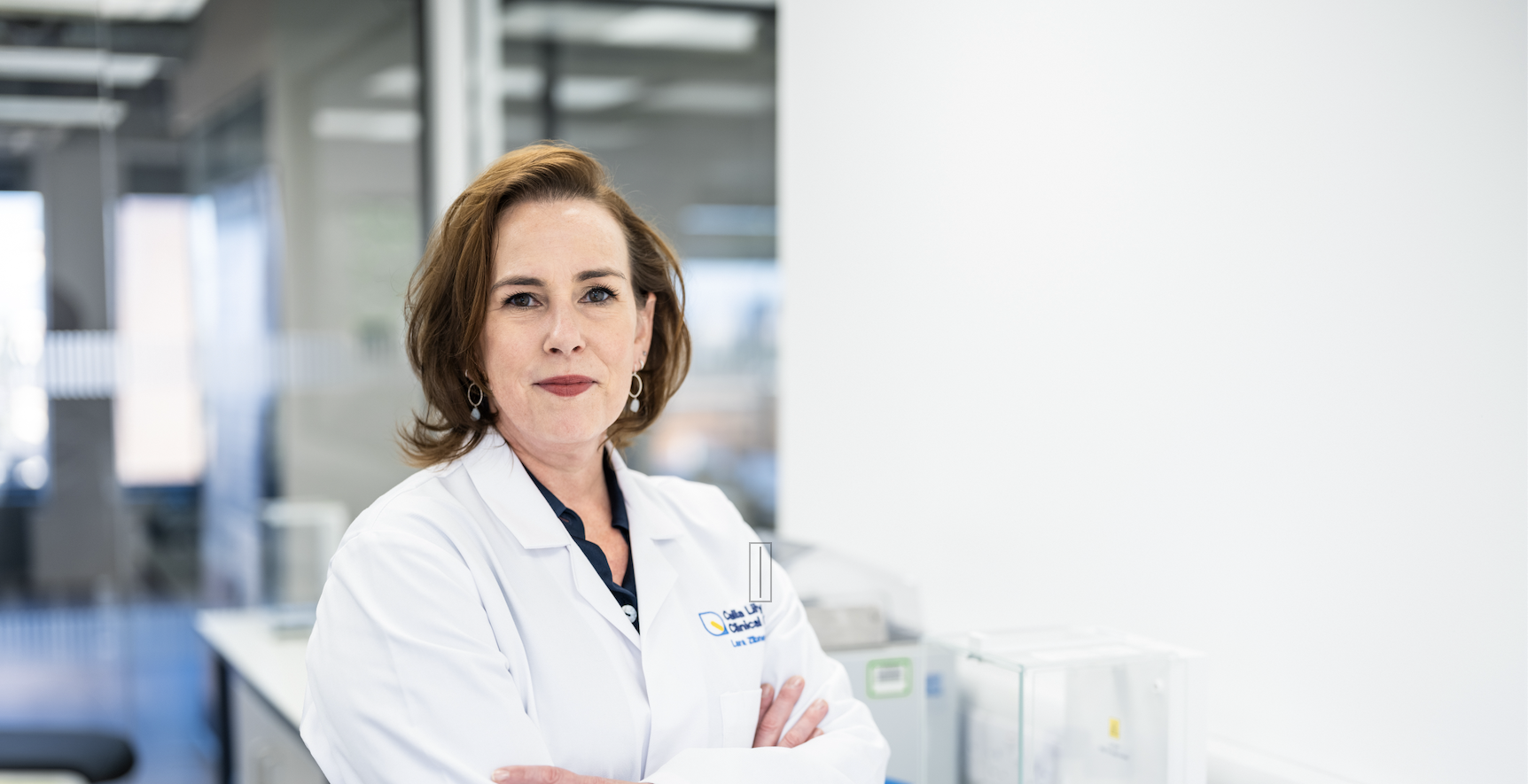“You Have to Be Completely Crazy”
– Lara Zibners on What It Takes to Build Biotech Breakthroughs in Women’s Health
From the ER to entrepreneurship, Lara Zibners feels like she’s on her eighth career.
After years navigating infertility alongside her work in trauma education, she never set out to build a biotech company. But when the moment came, she knew she was the right person for the job.
Today, she’s on a mission to transform vaginal drug delivery and improve care for millions facing IVF, miscarriage, or preterm birth. We sat down with Calla Lily’s co-founder to talk about building biotech rooted in lived experience and leading a team shaped by empathy, drive, and a strict no-jerks policy.
Tell us about your background! Have there been any pivotal moments that shaped your journey into biotech?
I grew up in California, trained as a pediatric emergency physician, and worked in New York before moving to the UK in 2006. I took an honorary consultant role at St. Mary’s, got involved in trauma education, and later earned a master’s degree in Medical Education. I’m currently the National Educator for Trauma Training at the Royal College of Surgeons.
Then, aged 50, I went back to school and completed an MBA. But the journey to co-founding Calla Lily actually came from a very personal place.
Between 2007 and 2009, I went through seven failed rounds of IVF. I later adopted two children and had a third via surrogate – my daughters are now 15 (born just 14 weeks apart!), and my son is 12.
I’d initially joined as an investor and advisor to Calla Lily, which developed the Tampliner – that’s our core technology. When UK guidance changed to recommend vaginal progesterone for women at risk of miscarriage, I was chatting with my now co-founder, Thang. He mentioned they held drug delivery patents, and through my personal experience, I knew exactly how problematic progesterone delivery could be.
Fast forward to 2022 – the consumer business hit a wall post-COVID, there was an opportunity to pivot, and we decided that we would make a great team. Thang comes from a Goldman Sachs background, and I brought clinical experience and an infertility story.
We’re now building a platform for vaginal drug delivery: right drug, right dose, right site… without the mess or side effects. Whether it’s for IVF, miscarriage, or preterm birth, there are so many reasons to deliver therapeutics vaginally. But until now, the experience has been incredibly unpleasant. We’re here to change that.
Honestly, this wasn’t part of the plan. I feel like I’m on my eighth career at this point!
Calla Lily is based in London, within the UK’s Brain Belt. How has that shaped the work you do?
My co-founder’s been in London for 25 years, and the previous company was based here, so it made sense to stay. But being in London – and in the UK more broadly – has been a huge advantage.
We’ve benefited from NICE guidance, great engagement with the MHRA, and incredible support from the UK government. We’ve had Innovate UK funding, and they even took us on a GBIP trip to New York and Boston. Plus, we received a £1.1 million NIHR grant that’s funding our first in-woman study this year.
We’re also EIS-eligible, which has shaped how we’ve raised. We have no institutional investment so far. It’s all been angels, networks, friends, and family offices. That EIS advantage has been massive.
And then there’s the London ecosystem itself. Once you’re in the innovation space here, you’re in the club, especially in women’s health. We all know and support each other. It’s a really rich, close-knit network which makes it easier to connect, collaborate, and host events.
Has being situated in the Brain Belt region made your hiring easier or more competitive?
Definitely easier. I’m going to brag a little here: we’ve built a really great culture. I’m definitely not the smartest person in the room! We’ve got brilliant PhDs, engineers, and product minds on board. We’ve also taken advantage of intern programmes and had PhD candidates choose to work with us for free just to be part of the energy here.
We also have a very strict no-jerks policy. We prioritise creating a positive culture and supporting personal development wherever we can. So far, we’ve had no trouble attracting really amazing talent.
How do you see the work that you’re doing impacting patients’ lives and the broader healthcare landscape in the next 5-10 years?
Everyone talks about how women’s health has been underfunded and ignored. And that’s true. But there’s another layer: women have been dismissed.
I’m a doctor, and I didn’t even feel able to complain during IVF. When you’re trying to have a baby, you don’t complain. You’re just grateful someone’s helping you.
What we’re trying to do is reduce some of the anxiety around IVF, recurrent miscarriage, and gynecological conditions, delivering treatments in a way that feels more respectful to women. And this isn’t just a women’s issue; it affects families, partners, and communities.
We want to create scientific solutions that respect the realities of women’s lives. We don’t have time to lie in bed for hours a day just to take our medicine.
What has been the biggest challenge in translating science into real-world application?
Funding. That’s the biggest challenge.
We’re building a physical product, and we have a growing full-time team. They all insist on eating, so we have to pay them!
So we’ve got a big burn rate. Lab space, compliance, regulation… all of it costs money. While Thang and I are flying around the world to secure funding, the team still has a product to build.
That’s part of my job: to share the mission and find people who want to support it. Fundraising is something you carry all the time. You feel a deep responsibility to your team – to make sure they get paid – and to the people who’ve invested in you. You do everything you can to make it work.
What leadership qualities do you think are the most important in driving a biotech company forward?
You have to be open to criticism, but also know how to filter it.
Listening to your team, encouraging honest opinions, even devil’s advocacy – that’s all essential. It helps you challenge assumptions and make sure what you’re building is robust.
At the same time, you have to be decisive. If you ask 10 people what they think of your pitch deck, you’ll get 53 opinions. Some will be valid and worth considering; others won’t. Eventually, you have to make the call and move forward.
We constantly tell our team: if you see something that doesn’t sit right, speak up. We might not act on every suggestion, but we want that level of challenge in the room.
To me, leadership isn’t about telling people where to go. It’s about creating something they believe in enough to follow you willingly.
The biotech market is notoriously challenging, especially now – what strategies or mindsets have helped you steer through difficult times?
You have to be wildly – sometimes stupidly – optimistic.
We joke that Thang is the Eeyore and I’m the Tigger… he’s the voice of reason, and I’m the eternal optimist. It’s a good balance. We share those fears and uncertainties between ourselves, then figure out a path forward.
I think that’s key: having someone to lean on. I couldn’t do this without him, and vice versa. When difficult moments come up, we process them together, work through the doubt, and present a united front to the team.
That sense of partnership – and protecting the belief that this is going to work – is what keeps us going.
As you mentioned, there’s a real sense of community within the London biotech ecosystem. What advice would you give other leaders in the sector on where to focus their energy and resources?
First and foremost: make sure the problem you’re solving is real. It’s easy to fall in love with your own solution, but if it’s not addressing an actual pain point, it won’t stick.
Second, do your homework. Know who else is out there solving the same problem. Some areas like fertility, menopause, or digital health are already crowded. Be brutally honest with yourself: are you actually different?
And then, do things the right way. Build carefully, surround yourself with the right people, and hold high standards. Because one bad actor can damage the entire ecosystem. So be thoughtful about who you bring in, and how you build.
How do you balance the demands of leadership with maintaining your own curiosity and passion for the mission?
You don’t! Every day I wake up feeling a bit overwhelmed. But I’m so lucky. I have an incredible husband, amazing kids, and they’re all part of this story. They’ve been so supportive.
As terrifying as it is, I’m actually having the time of my life. I’m meeting incredible people, having meaningful conversations, and finding a platform and a voice. Not just as a doctor or founder, but as someone who’s lived through these experiences.
I think because I’m older, because I’ve got a few degrees behind me and personal experience in this space, I’ve always felt comfortable being open about it. And in a way, this work is helping me process what I went through while trying to build a family – giving it a sense of purpose I never expected I’d find, especially not 16 years after my last round of IVF.
So while the leadership pressure is real, the passion is very real too. And that’s what keeps me going.
Finally, if you could give a single piece of advice to yourself when you were first starting off on this journey, what would it be?
“Are you crazy?” That’s exactly what I’d say to myself!
But I’m so happy I didn’t listen to the voice of reason. I was so naive about what I was getting into and I certainly don’t do things by halves… whether it’s seven rounds of IVF, adoption, or going back for an MBA to learn finance. My advice is that you have to truly believe there’s nothing you can’t do.
At the same time, surround yourself with people who remind you it’ll be okay even if things fall apart, because something else will come from the journey. It will open new doors.
So yeah, you have to be completely crazy… but that’s often what it takes to be successful.

Lara and Calla Lily were recently featured in the Hlx Life Science’s Brain Belt 50 report, spotlighting 50 founders and scientific leaders driving life science innovations across the UK’s brain belt.






